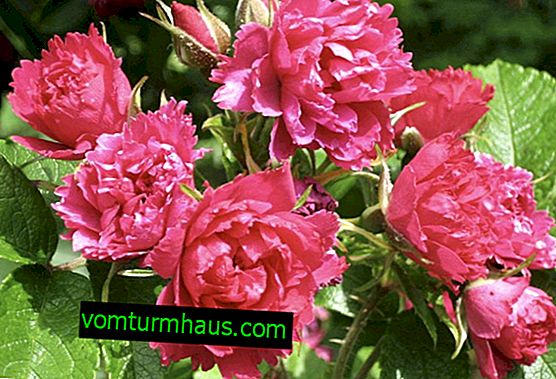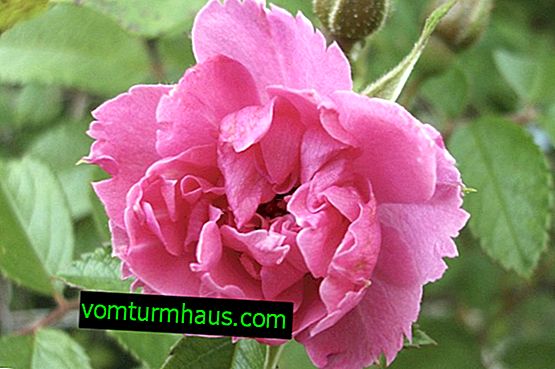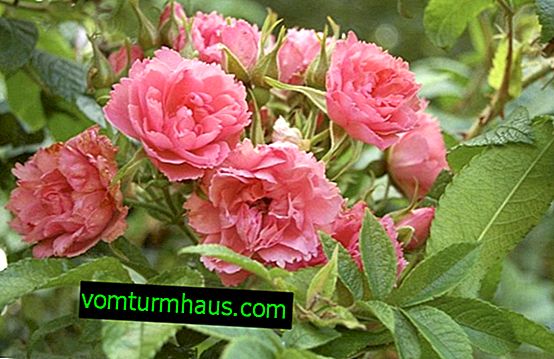Rosa Rugosa: planting and care in the open ground
Wrinkled rose - one of the brightest representatives of garden plants, fell in love with many for its incredible attractiveness and versatility. For many years, it acts as a decoration of landscapes and is used for medicinal and culinary purposes. Most flower growers know her under the names "rosehip" or "rose of Rugosa" and appreciate her unpretentiousness in care and long plentiful flowering. Our article invites you to familiarize yourself with the different varieties and hybrids of the shrub, its use in landscape design, as well as tips on care and possible difficulties in growing.
Botanical description of the plant
Rosa Rugosa is an ornamental shrub reaching a height of about 2–2.5 m. In the natural environment of growth, it can be found in almost all countries of the Far East, but Japan is considered to be the birthplace of the plant. This unusual flower attracted the attention of domestic breeders only at the beginning of the 20th century, and now they tirelessly conduct various experiments to create new varieties and hybrids.

The plant is characterized by many features, one of which is the formation of massive woody shoots that do not need pruning. Depending on the variety, they can be either needle-shaped or sickle-shaped and most often covered with spikes of different lengths and widths, but fully exposed specimens can also be found. The shape of the bushes is also due to their appearance - they can be either creeping or liana-shaped.
A wrinkled rose was named after its unusual foliage - it is tuberous from the outside, with characteristic notches directed to the bottom. In addition, the leaves attract attention with a rich dark green color, they are collected in 8-10 pieces on one petiole. The flowers are semi-double, rather large, as a rule, are located singly and can be of very different shades of pink, yellow or white.

Flowering begins in May-June and continues until the first frost with a gradual discharge of flowers, which, however, does not affect the attractiveness and general appearance of the bush. Most hybrids exhibit repeated flowering in mid-autumn. After flowering, in place of fallen flowers, fruits form that acquire a bright orange color. They are widely used in cooking and medicine, collecting from one bush up to about 4 kg. The maximum weight of the fruits of Rugosa does not exceed 60 g.
Varieties and hybrids
Both foreign and domestic breeders bred a huge number of varieties and hybrids of Rugosa, characterized by high decorativeness. In addition, they are all united by a very pleasant sweetish aroma of flowers and their sizes, as well as the benefits of fruits, which are widely applicable in various fields of human life. Today, varieties of roses are very valuable and in demand, in the name of which there is the prefix "Grotendorst."
Check out other rose varieties:
This is the name of the famous Dutch rose grower who lived more than a century ago and was actively involved in hybridization, and today the company Rosenberg und Grotendorst is named after him. So, the best varieties and hybrids are presented below:
- "F. J. Grothendorst, or Nelkenrose. To obtain this variety, the creators crossed little-known varieties of Rugosa Rubra and Polyanthus, and as a result, they created an incredibly beautiful specimen decorated with fancy bouquets of 10-30 small bright red flowers with a rich aroma. External resemblance to cloves served as the acquisition of a second name variety (Nelkenrose). In the conditions of our climate, this erect shrub can reach a height of 2 m. The leaves are glossy, spiky, dark green with a characteristic sheen. It blooms very abundantly and for a long time - all summer, and, like the other varieties, pleases with repeated flowering. The variety is also characterized by cold hardiness and extremely rarely freezes, even at record low temperatures.

- "Pink Grotendorst." No less popular version of the variety described above, characterized by an unusual pyramidal shape of the bush, the height of which does not exceed 1.5 m. The branches are very sprawling, and the shiny leaves are light green in color. The flowers are small, double, light pink, odorless, collected in inflorescences of 10-20 pieces. From other varieties, this variety is distinguished by the cut edges of the petals, which looks very unusual and decorative. Abundant and continuous flowering is observed throughout the summer and autumn. This variety is noteworthy for its high resistance to frost and disease, as well as its unpretentiousness in content and the duration of flowering.

- "Alba." A very unusual hybrid, small flowers of a bright white hue with golden stamens adorn it until the fall, having a light aroma. Foliage, rapidly yellowing to the onset of cold weather, is large enough and wrinkled, usually arranged in 10 pieces. The size of the bush is identical to the previous varieties, and according to the rest of the characteristics, “Alba” is in no way inferior to other Rugozy. The hybrid is winter-hardy enough, rarely susceptible to disease and tolerates the most adverse conditions. It blooms profusely from the beginning of summer to September. Thanks to the non-standard appearance, it looks very impressive as a hedge and in decorative shrubby compositions.

- "Grotendorst Suprim." Very bright variety of the initial variety "Grotendorst". It attracts attention with an exquisite raspberry shade of flowers, reminiscent of bouquets of carnations from afar. One stalk usually accounts for 10-15 pieces, forming small inflorescences and effectively stand out against the background of dark green shiny foliage. Spreading shrub up to 2 m high, flowering long and plentiful, able to re-repair in the fall. The hybrid is quite hardy, tolerates low temperatures and other adverse environmental conditions. Well suited for creating hedges or group plantings.

- Agnes. The plant has spiky woody shoots, large spikes and wrinkled shiny leaves of olive color with carved edges. This hybrid is characterized by many advantages - a pleasant fruity aroma, bright color of flowers, ranging from a soft golden hue to ivory, and high resistance to disease. The flowers are very large - 10 cm in diameter, double, located singly, and the petals are easily showered after rain or wind. The bush is straight and tall, usually not exceeding 2 m. Flowering begins very early and lasts no more than a month. Despite frost resistance, it quickly freezes without shelter.

- "Hansa." A very elegant rose variety of Rugosa, is very popular with flower growers who celebrate the fabulous beauty of flowers whose color is of a pure purple hue and unpretentiousness in content. The bush is symmetrical, well leafy, ideal for creating hedges, but can also grow separately from other plants due to its small size. The flowers themselves are large, semi-double, with golden stamens and a rich aroma, noticeably differ from the other varieties in their shapelessness. Bright green wrinkled leaves in autumn are characterized by a change in color to yellow, orange and red shades. The abundant first flowering, lasting all summer, is followed by a repeated autumn wave. This hybrid, completely frost-resistant and resistant to all diseases, does not create any problems in care. After flowering, a large number of fleshy burgundy fruits are formed on the bush.

Landscape design
A huge selection of different varieties of rose Rugosa allows it to be very profitably used in landscape design, especially given its ability to clean the surrounding air from pollution. The shrub found the most active application in creating impenetrable hedges, which additionally serves to protect the site from uninvited guests, and the formation of fruits after flowering gives the opportunity to enjoy such a hedge all year round, without making much effort to maintain it.
Rugosa roses are planted as independent plants. The range of application of a wrinkled rose as a decoration for various places of rest is also very wide, and Rugosa is also a favorite of landscape designers who prefer to create numerous ethnic compositions from it, combining it with other plants.
The most profitable and interesting combinations of rose Rugosa with juniper, any coniferous or deciduous tree, spirea and even stones - such compositions are called "rockeries". In addition to decorative purposes, the shrub also serves as an excellent environmental and natural barrier, as it reliably strengthens coasts, ravines and cleans the air in the industrial zone.

Planting seedlings in open ground
Even novice and inexperienced flower growers can cope with the planting of a wrinkled rose. Entering the category of plants that are completely undemanding to the soil and place of growth, it also easily tolerates a sharp change in temperature and drought, but in order to get the most beautiful and saturated color of flowers, it is better to take care of creating the most optimal conditions for its growth and development.
Seat selection
A wrinkled rose is an undemanding plant, but it feels most comfortable in bright sunlight, therefore a well-lit and sheltered from the wind slope of the south or west side is suitable.
Soil moisture for Rugosa roses is also not a decisive factor, but for the fastest growth and development it is better to use a substrate with a low level of acidity.

Important! Despite the fact that the leaves of Rugosa are quite dense and hard, they are very easy to burn, so care for the rose with the help of chemicals is carried out with extreme caution.
Scheme and Depth
The most suitable time for planting the plant is considered to be early spring, until the buds open, but planting is also acceptable in autumn, if the characteristics of the variety allow. Depending on the purpose of the procedure, the distance between the seedlings can be different:
- if we are talking about creating a hedge, in this case it is necessary to make an interval of at least 70 cm;
- if the bush is planned to be planted alone, it is recommended to build a vertical fence, for example, with sheets of roofing iron, maintaining a distance between plantings of 2 m;
- group plantings of Rugosa rose with other plants require a mandatory distance of 1.5 m.

You will probably be interested in learning how to grow roses from seeds.
Care Tips
Rosa Rugosa - the plant is absolutely capricious and does not require significant expenditures of time and effort. One of the many advantages of the bush is also its ability to fully grow and develop without transplanting for 30 years, but for this you need to follow simple rules. We consider them further in detail.
Watering
Rugosa, because of its heat resistance, does not like excess moisture, so watering the plant needs to be provided with a rare, but plentiful - at least 10 liters per bush. The most acceptable option is watering the bush only once a week, while the substrate should be drained and moderately moist.

Did you know? The oldest rose on the planet is more than 1000 years old, and it grows in Germany, at the cathedral in Hildesheim. Moreover, despite the damage during the war years, the plant survived and began to grow with renewed vigor, sprouting from the remaining root.
Fertilizer application
Wrinkled rose fertilizer will be needed only in the third year of life, and before that it is not recommended to overload the plant with various nutrient components. In specialized stores, you can buy ready-made mineral fertilizers labeled “for roses, ” but the greatest nutritional value for the plant is urea, which is applied every spring at a rate of 40 g per 1 m². After the fruiting of the bush begins, the feeding scheme changes slightly and is done like this:
- every few years, the bush is necessarily fertilized with organic components - humus, mullein or bird droppings (15 kg per 1 m²);
- mineral fertilizers are applied at the same frequency, namely 60 g of superphosphate and 10 g of potassium salt.
Video: Rose Feeding Calendar
Loosening and weed control
To increase life expectancy and reduce the risk of diseases of the rose Rugosa, it is necessary to regularly eliminate weeds and loosen the soil around the bush. Usually this procedure is carried out at the end of May, then stops for some time to exclude further enhanced plant growth.

Particular attention should be paid to this process in the heat, immediately after watering. It will also be useful to loosen the substrate after prolonged rains, after it has covered with a crust. However, it should be remembered that too deep loosening is detrimental to the rose, so 10-15 cm is a suitable depth. It is also recommended to protect the wrinkled rose from other, weaker plants.
Pruning
Pruning a bush in order to rejuvenate it is a mandatory procedure for the care of wrinkled roses. Rugosa is usually cut off a few weeks before a cold snap or in the spring by the time the buds open. As in the case of top dressing, they begin to conduct this event in the third year after planting. It includes the removal of broken and lying on the ground branches, as well as root offspring, far removed from the bush.
Read more about correct pruning of roses.
The surviving shoots are pruned at a height of 15 cm and leave about 6-7 healthy branches. With the formation of new shoots, they are periodically shortened to the fourth part, as soon as their growth exceeds 80 cm. This will ensure a better development of the branches and accelerate the fruiting process. Subsequent execution of the procedure is reduced to the regular removal of unproductive, weak and painful branches, usually reaching the age of 6–7 years.

Important! The pruning procedure must be carried out by pruners and gloves, be sure to not hurt your hands on sharp spikes.
Wintering
Rugosa is characterized by incredible winter hardiness, which allows it to survive record low temperatures, so in most cases it does not need winter shelter. In just a few varieties during prolonged frosts, aboveground parts can freeze, which in this case involves shelter with cellophane. In general, it is simple enough to mulch the soil under the bush with sawdust.

Possible growing difficulties
Almost all varieties of Rugosa, in addition to frost resistance, are also resistant to diseases and pests, however, if the defeat does occur, it is solely due to non-compliance with the cultivation agricultural technique. Наиболее частыми вредителями, атакующими растение, выступают паутинный клещ, листовёртка и пилильщик. Они появляются в момент наибольшего ослабления растения от недостатка освещения, поливов и подкормок.
Профилактические меры по предупреждению насекомых следующие:
- регулярная санитарная обрезка;
- уничтожение растительных отходов и сгнивших плодов в осенний период;
- проведение плановой перекопки вокруг куста и тщательный осмотр растения на наличие кладок яиц вредителей;
- обработка розы химическими препаратами в превентивных целях — проводится 1% бордосской жидкостью дважды: до наступления заморозков и ранней весной до распускания почек.
Find out what to do if the leaves turn yellow.
Не застрахована Ругоза также и от болезней, признаками которых могут стать стремительное пожелтение и опадание листьев или появление на них коричневых пятен без видимой на то причины. Всё это характерная симптоматика таких грибковых инфекций, как мучнистая роса, серая гниль и ржавчина. Причины их возникновения чаще всего обусловлены избытком влаги, и обычно, когда цветовод нормализует процесс полива, ситуация стабилизируется. Однако в критических условиях всё же рекомендуется прибегнуть к использованию фунгицидов. Отсутствие своевременно принятых мер чревато стремительным распространением болезни и гибелью растения, поэтому не стоит откладывать лечение.

Did you know? Аромат роз является одним из сильнейших антидепрессантов.
Неприхотливость и широкое применение морщинистой розы позволяют выгодно её использовать как в декоративных, так и кулинарных, и даже медицинских целях, а устойчивость, которой могут позавидовать большинство растений, — лишь одно из большинства преимуществ розы Ругоза.









